

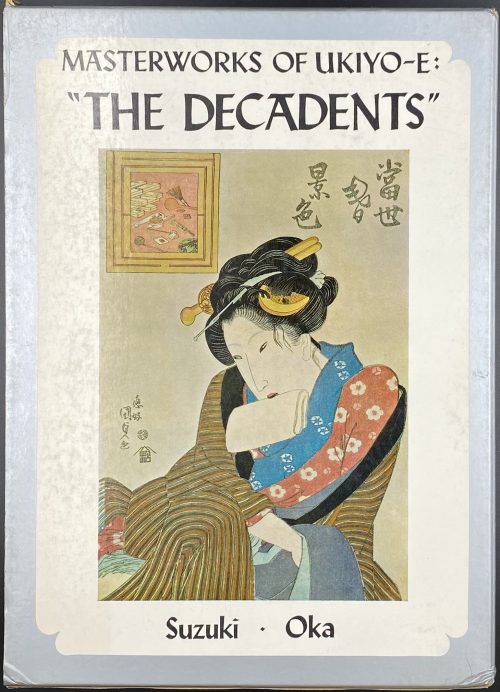




Size: 74.3 x 71.8 x 3.2 mm.
NBTHK certificate №4003986: Hozon (worthy preservation). In custom wooden box.




Kokusai Tosogu Kai 5th, 2009, p. 51, № 5-U8: ko-kinko or tachi-kanagushi tsuba.

Size: 83.2 x 82.4 x 3.6 mm; 149.2 g
The Carlo Monzino Collection of Japanese sword fittings and swords (Sotheby's, London, 18 June 1996. p. 12-13) №9 provides an illustration of the similar tsuba with the following description: Heianjo tsuba, carved and inlayed with rocks, plants, and waves, also pierced with a jakago [sic] (stone basket).
Gary D. Murtha in his Japanese sword guards Onin - Heianjo - Yoshiro (GDM Publications, 2016) on page 53 shows a look-a-like tsuba (though, with a kogai-hitsu-ana) with the follwoing description: Iron, 77 mm, tsuba with brass tree, snake, jakugo baskets, and curved brass pieces (representing water flowing over rocks). Buddhist halo to reverse. Although showing Onin traits, a Shoami Heiamjo attribution would fit better. Azuchi-Momoyama period.


Iron tsuba of oval form decorated with design of jakago (bamboo lattice work) in openwork (sukashi). Copper sekigane.
Unsigned. Edo period.
Size: 73.7 x 70.3 x 5.6 mm.Note regarding design: though some might think that this piece belonged to a member of the lost tribe of Israel, it did not. Jakago baskets were made of bamboo, filled with rocks and used to catch crabs (besides other uses).

Jeanne Allen. Designer's Guide to Samurai Patterns. Chronicle Books, San Francisco, 1990; p.51, №57.
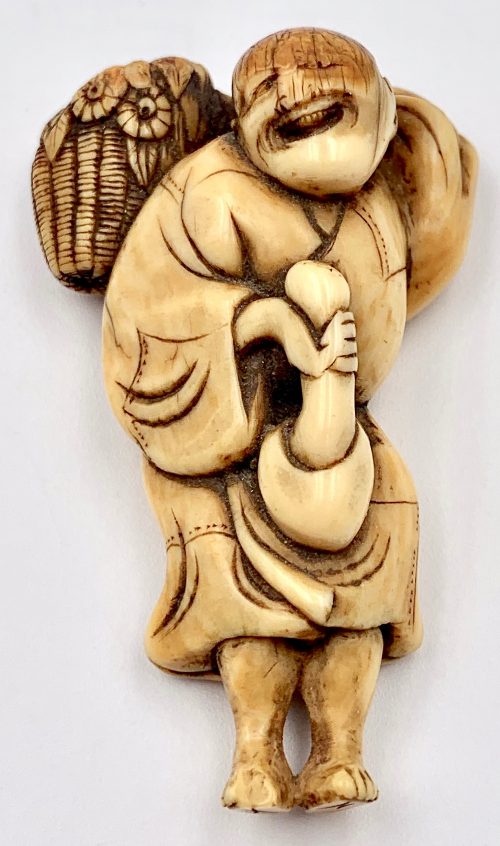
Netsuke with a design of a laughing peasant carrying a basket and holding a giant mushroom in his right hand.
18th century Dimensions: 55.7 mm tallUnsigned. According to Merrily Baird (Symbols of Japan, page. 93): ...Theis prominent use in the symbol-rich netsuke art form, however, reflects more their sexual symbolism than either their dietary appeal or interesting shapes. Mushrooms in Japan are generally a symbol of fertility, with some flat varieties, like shiitake, being associated with females. In contrast, the matsutake mushroom (Armillaria edodes) is a phallic symbol, as befits its thick, spearlike stem and the fact that it is consumed before cap opens.

Female Daruma Riding a Mushroom. Ippitsusai Bunchô. MFA impressions: 11.18513, 21.4758
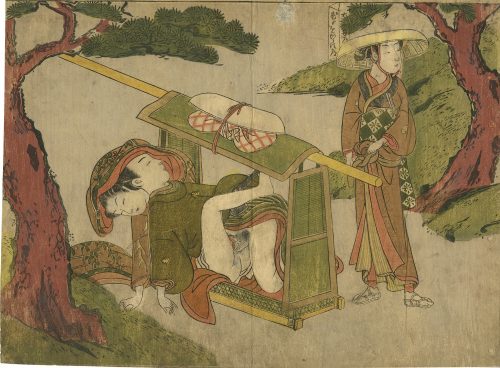

http://www.metmuseum.org/art/collection/search/45071
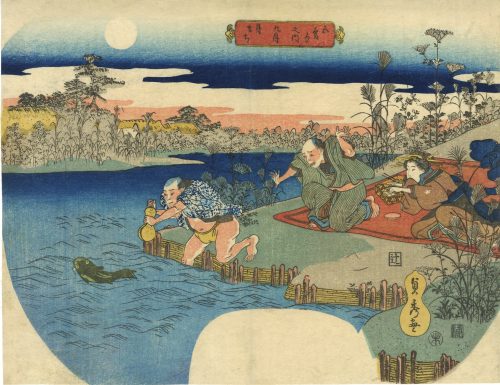




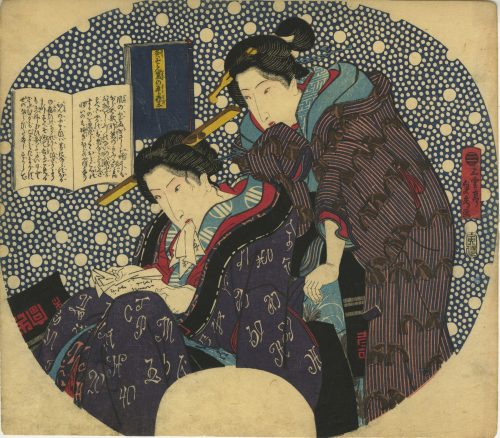

RISDM 13-1383
| Yukari no Edo-zakura | The tatami night robe of Iwao | Tangled Hair and the Evening Braided Hat |





Jeanne Allen. Designer's guide to Samurai Patterns. Chronicle Books, San Francisco, 1990. Page 114, №130.

Tears That Brought Bamboo-shoots From the Frozen Earth: Meng Zong Meng Zong lived during the Three Kingdoms Period of China's past. His father died when he was young, and he and his mother struggled to survive. One winter his mother was stricken with a serious illness, and craved some bamboo-shoot broth as medicine. But in the depths of winter, with snow and ice blanketing the ground, where was anyone to find fresh bamboo shoots, shoots that emerge only in the warm months? Nonetheless, Meng Zong, to avoid disappointing his mother, bravely fetched his shovel and went out into the white landscape in search of bamboo shoots. In the thicket he found only frosted leaves and green stalks coated with snowflakes and ice. Look as he might, there were simply no fresh shoots growing in the winter. The thought of his poor mother lying sick on her bed, waiting for bamboo-broth medicine, made his heartache. Uncontrollably, tears began to fall in rivers to the ground beneath the tall, emerald canes. Even now, as his tears flowed down, he kept a light of faith in his heart. If he was truly sincere in his search, perhaps.... Just then Meng Zong nearly tripped and fell over a sharply protruding lump of earth. He quickly knelt down and knocked aside the dirt with his trembling fingers. How uncanny! Underneath his frozen hands he discovered a bed of fresh, tender bamboo shoots! Overjoyed, he gathered up a coatful and carried them back home. The broth that he quickly set stewing in the pot soon cured his mother's illness. The neighbors, hearing the story, exclaimed that it was the strength of his sincere, unselfish, filial resolve that inspired heaven and earth to respond, and to bring up, out of season, the fresh shoots that cured his mother's disease. Before Meng Zong's prayers generated this miracle, it was normally considered impossible for bamboo shoots to grow in the winter. After the nmiracle took place, however, people were able to gather and to eat bamboo shoots all year round. The winter variety that existed hereafter became known as "winter shoots." The villagers were deeply influenced by Meng Zong's courage and devotion. They renamed the spot where the event took place, "Meng Zong's Bamboo Grove". We can now enjoy bamboo sprouts during the winter as well, and as we do so, it is fitting to recollect Meng Zong's outstanding example of filial respect, and reflect on our conduct as sons and daughter of our parents. A verse in his honor says, His teardrops transformed winter at the roots; Up from the ice crept tender bamboo shoots. Instantly, the winter-sprouts matured; Heaven's will: a happy, peaceful world.